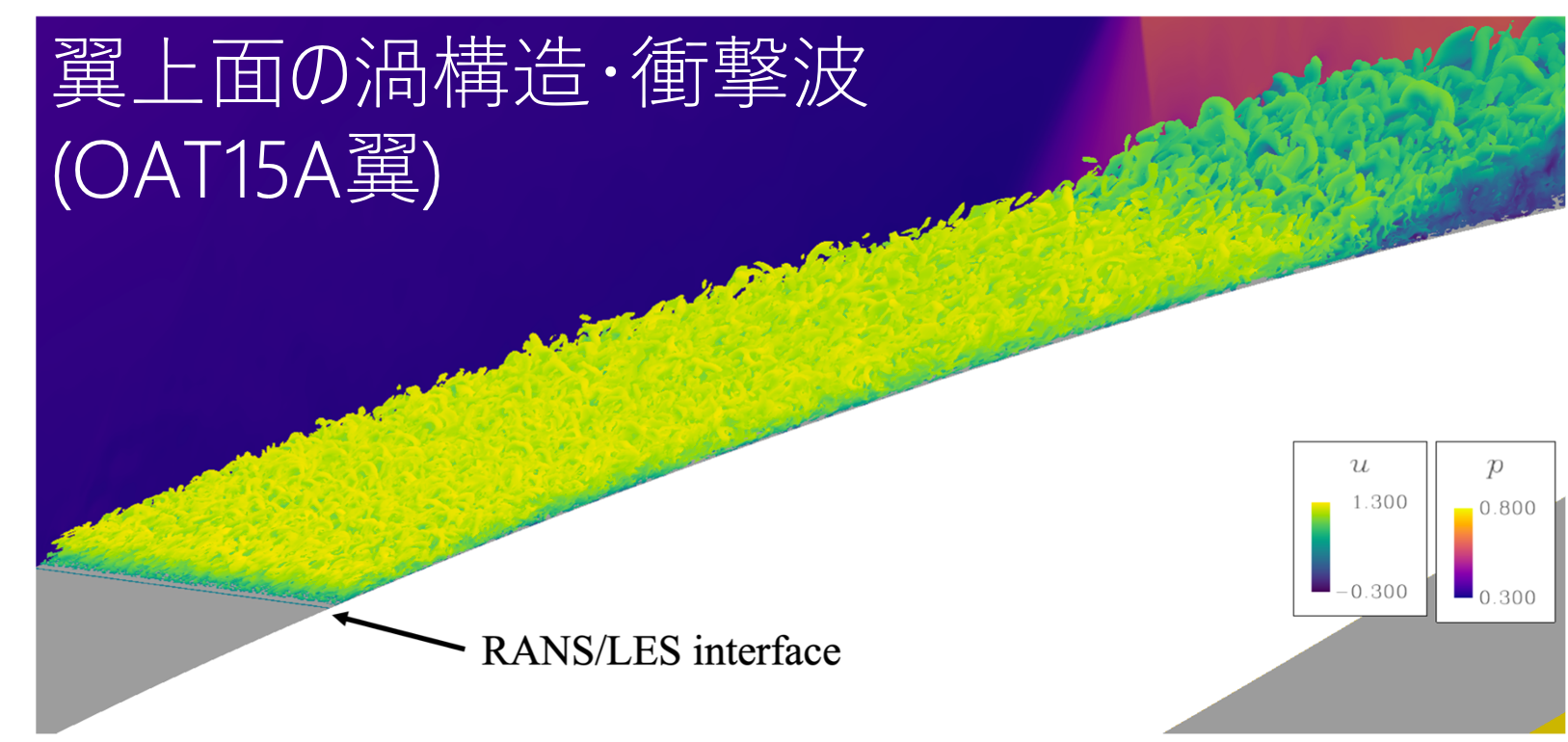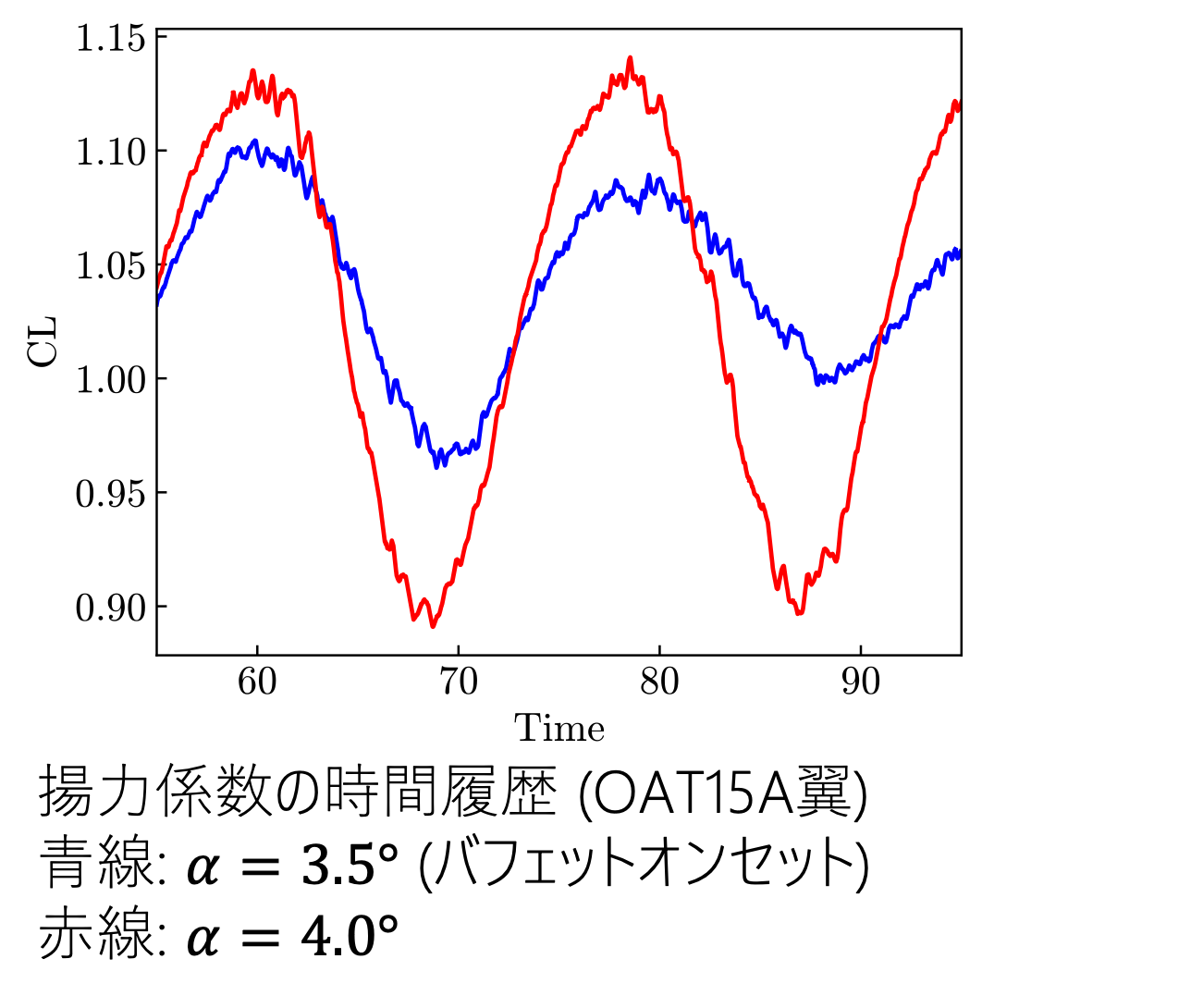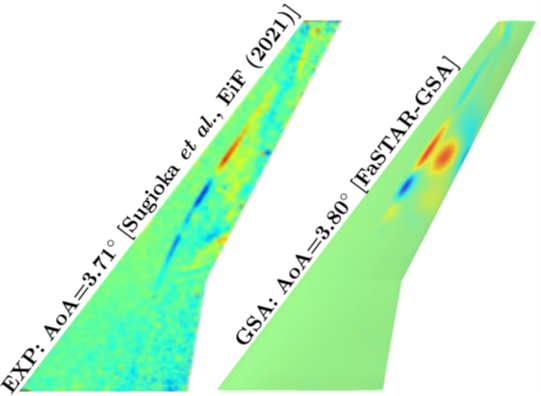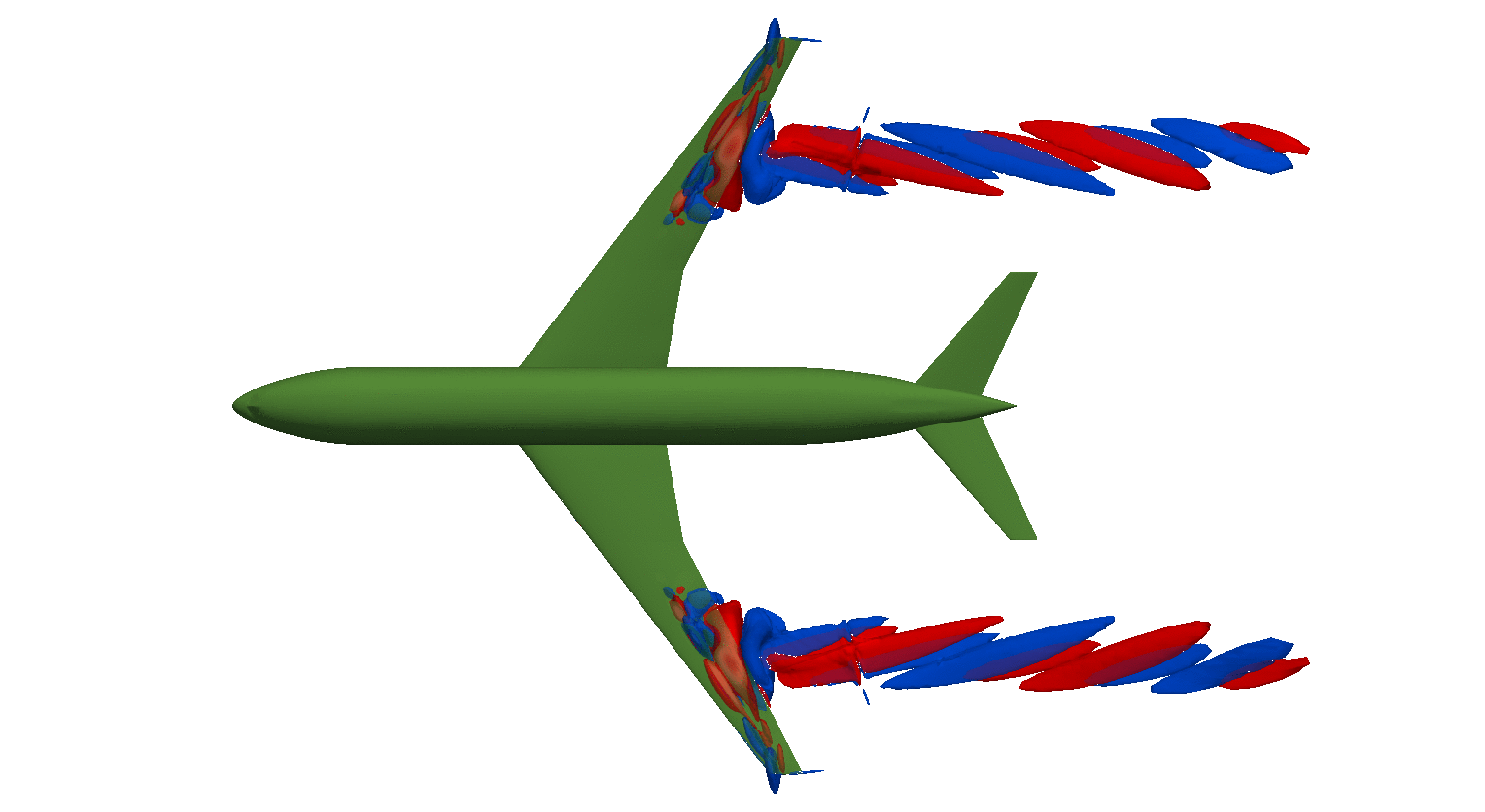Research on unsteady flow simulation toward prediction of full flight envelope
JAXA Supercomputer System Annual Report February 2021-January 2022
Report Number: R21EDA201N01
Subject Category: Aeronautical Technology
- Responsible Representative: Takashi Aoyama, Director, Aircraft Lifecycle Innovation Hub, Aviation Technology Directorate
- Contact Information: Yoimi Kojima, Andrea Sansica(kojima.yoimi@jaxa.jp,sansica.andrea@jaxa.jp)
- Members: Hitoshi Arizono, Manabu Hisida, Atsushi Hashimoto, Kenji Hayashi, Yuki Ide, Takashi Ishida, Hiroki Kato, Masashi Kanamori, Tomoaki Matsuzaki, Andrea Sansica, Keita Nakamoto, Yoimi Kojima, Yosuke Sugioka, Paul Zehner, Yoshine Ueda, Kanako Yasue, Takahiro Yamamoto
Abstract
The transonic buffet is one of the unsteady phenomena on the normal shock wave, which stands on an aircraft wing in transonic flow, and can affect aircraft safety. We aim to develop the Embedded Large Eddy Simulation (ELES) to improve buffet prediction accuracy and help aircraft design. In our plan, the ELES method will be tested on two-dimensional airfoils and finally adopted to commercial aircraft with complex, three-dimensional shapes. We also develop the global stability analysis (GSA) method to predict the buffet with low-cost. We validate the GSA method to predict high-speed buffet onset for NASA-CRM geometries.
Reference URL
N/A
Reasons and benefits of using JAXA Supercomputer System
Since the ELES method needs high-resolved computation for the wall turbulence, the simulation requires enormous computational resources that our desktop workstations cannot privide. Furthermore, the large amounts of simulation data also require vast storage and GPU resources to save and visualize them.
The resources provided by JSS is also essencial to perform the gloval stability analysis in this research. While conventional local stability is a one dimensional analysis limited to simple shapes, global stability analysis can handle any arbitrary flow field having three-dimensional complex shape. However, to achieve high-accuracy, large computational power is required and JAXA Supercomputer System is needed.
Achievements of the Year
We tested the ELES method by conducting a numerical simulation of transonic buffet flow over an OAT15A airfoil. The visualization of the shock wave and vortex structures on the suction side (figure 1) shows that the inflow-turbulence is introduced as we expected and the shock-boundary-layer interaction is simulated with reasonable accuracy. Also, the time-evolution of the lift coefficient (figure 2) indicates that the present simulation could have a potential to predict the buffet onseet. In order to perform global stability analysis for three-dimensional complex shapes, we developed and verified an global stability analysis code (FaSTAR-GSA) based on the fluid analysis code FaSTAR. FaSTAR-GSA predicts the onset with an error of 0.2 degrees, and the GSA frequencies and modes are in good agreement with the experimented carried out at JTWT1 (Fig. 3). Using the GSA mode, it is possible to investigate the three-dimensional perturbation distribution (Fig. 4). FaSTAR-GSA supports turbulence, shock waves, complex shapes, 3D and large-scale grids, being the highest performance global stability code in the world.
Publications
- Peer-reviewed papers
1) Andrea Sansica , Jean-Christophe Loiseau, Masashi Kanamori, Atsushi Hashimoto and Jean-Christophe Robinet, "System Identification of Two-Dimensional Transonic Buffet", AIAA Journal, 2022. https://doi.org/10.2514/1.J061001
- Non peer-reviewed papers
1) Yoimi Kojima, Atsushi Hashimoto, "Embedded Large Eddy Simulation of Transonic Flow over an OAT15A Airfoil", AIAA 2022-0464, AIAA SCITECH 2022 Forum, January 3-7, 2022
2) Yoimi Kojima and Atsushi Hashimoto, "Numerical simulation of transonic buffet flow over an OAT15A airfoil with Embedded-LES method", 53rd Fluid Dynamics Conference / 39th Aerospace Numerical Simulation Symposium, 2021.
3) Andrea Sansica, Atsushi Hashimoto, Shunsuke Koike and Toshinori Kouchi, "Side-Wall Effects on the Global Stability of Swept and Unswept Supercritical Wings at Buffet Conditions", AIAA 2022-1972, AIAA SCITECH 2022 Forum, January 3-7, 2022
4) Andrea Sansica and Atsushi Hashimoto, "Prediction and Characterization of Buffet for ComplexConfigurations Using Global Stability Analysis", 53rd Fluid Dynamics Conference / 39th Aerospace Numerical Simulation Symposium, 2021.
- Invited Presentations
1) Andrea Sansica, "The role of CFD and numerical simulations in the 4th industrial revolution", invited speaker to Seminar Series at the Ecole des Mines de Saint-Etienne, Saint-Etienne, France
- Oral Presentations
1) Yoimi Kojima, Atsushi Hashimoto, "Embedded Large Eddy Simulation of Transonic Flow over an OAT15A Airfoil", AIAA 2022-0464, AIAA SCITECH 2022 Forum, January 3-7, 2022
2) Yoimi Kojima and Atsushi Hashimoto, "Numerical simulation of transonic buffet flow over an OAT15A airfoil with Embedded-LES method", 53rd Fluid Dynamics Conference / 39th Aerospace Numerical Simulation Symposium, 2021.
3) Andrea Sansica , Jean-Christophe Loiseau, Masashi Kanamori, Atsushi Hashimoto and Jean-Christophe Robinet, "System Identification on Two-Dimensional Transonic Buffet", MMLDT-CSET Conference, September 29, 2021
4) Andrea Sansica , Jean-Christophe Loiseau, Masashi Kanamori, Atsushi Hashimoto and Jean-Christophe Robinet, "System Identification on Two-Dimensional Transonic Buffet", IFAR Workshop, November 4, 2021
5) Andrea Sansica, Atsushi Hashimoto, Shunsuke Koike and Toshinori Kouchi, "Side-Wall Effects on the Global Stability of Swept and Unswept Supercritical Wings at Buffet Conditions", AIAA 2022-1972, AIAA SCITECH 2022 Forum, January 3-7, 2022
6) Andrea Sansica and Atsushi Hashimoto, "Prediction and Characterization of Buffet for ComplexConfigurations Using Global Stability Analysis", 53rd Fluid Dynamics Conference / 39th Aerospace Numerical Simulation Symposium, 2021
- Poster Presentations
Atsushi Hashimoto, Sansica Andrea, Yuya Ohmichi, Masashi Kanamori, "Research and Development of Aircraft Digital Integrated Design by using MBSE (Model Based Systems Engineering)", JAXA Aviation Symposium 2021.
Usage of JSS
Computational Information
- Process Parallelization Methods: MPI
- Thread Parallelization Methods: N/A
- Number of Processes: 256 - 9600
- Elapsed Time per Case: 100 Hour(s)
JSS3 Resources Used
Fraction of Usage in Total Resources*1(%): 3.85
Details
Please refer to System Configuration of JSS3 for the system configuration and major specifications of JSS3.
| System Name | CPU Resources Used(Core x Hours) | Fraction of Usage*2(%) |
|---|---|---|
| TOKI-SORA | 86151277.08 | 4.19 |
| TOKI-ST | 1254373.77 | 1.54 |
| TOKI-GP | 172.67 | 0.11 |
| TOKI-XM | 1302.08 | 0.94 |
| TOKI-LM | 89187.94 | 6.65 |
| TOKI-TST | 0.00 | 0.00 |
| TOKI-TGP | 0.00 | 0.00 |
| TOKI-TLM | 0.00 | 0.00 |
| File System Name | Storage Assigned(GiB) | Fraction of Usage*2(%) |
|---|---|---|
| /home | 1019.91 | 1.01 |
| /data and /data2 | 108831.90 | 1.16 |
| /ssd | 1658.95 | 0.43 |
| Archiver Name | Storage Used(TiB) | Fraction of Usage*2(%) |
|---|---|---|
| J-SPACE | 86.19 | 0.58 |
*1: Fraction of Usage in Total Resources: Weighted average of three resource types (Computing, File System, and Archiver).
*2: Fraction of Usage:Percentage of usage relative to each resource used in one year.
ISV Software Licenses Used
| ISV Software Licenses Used(Hours) | Fraction of Usage*2(%) | |
|---|---|---|
| ISV Software Licenses(Total) | 4555.87 | 3.19 |
*2: Fraction of Usage:Percentage of usage relative to each resource used in one year.
JAXA Supercomputer System Annual Report February 2021-January 2022






